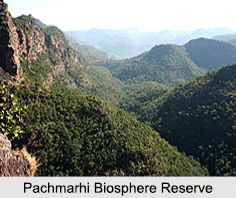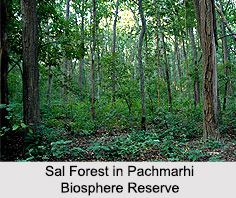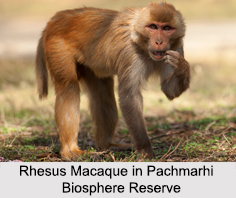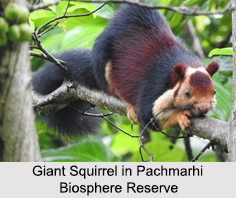 The Pachmarhi Biosphere Reserve is a renowned reserve all over India. It is one of the premiers in Indian Biosphere Reserves. The Pachmarhi area was designated as a biosphere reserve by the Government of India on the basis of project document prepared by the Environmental Planning and Coordination Organisation (EPCO). The EPCO is an advisory body to the State Government of Madhya Pradesh.
The Pachmarhi Biosphere Reserve is a renowned reserve all over India. It is one of the premiers in Indian Biosphere Reserves. The Pachmarhi area was designated as a biosphere reserve by the Government of India on the basis of project document prepared by the Environmental Planning and Coordination Organisation (EPCO). The EPCO is an advisory body to the State Government of Madhya Pradesh.
History of Pachmarhi Biosphere Reserve
Pachmarhi Biosphere Reserve was established on 3rd March, 1999 looking at the vast natural resources, diverse and rich flora and fauna, unique topography and geographic situation, inhabitation of large tribal population in the State of Madhya Pradesh. The conservation history of the Pachmarhi Biosphere Reserve is quite long. The scientific management and conservation of the Indian forests was started for the first time in the year 1865, by separating the Bori Reserve Forest that lies in Bori Wildlife Sanctuary at present.
 Geography of Pachmarhi Biosphere Reserve
Geography of Pachmarhi Biosphere Reserve
The Pachmarhi Biosphere Reserve is located covering the Hoshangabad District, Betul District and Chhindwara District of the State. The total area of the reserve is 4926.28 sq km and it envelops three wildlife conservation units like the Bori Sanctuary, the Satpura National Park and the Pachmarhi Sanctuary. The Satpura National Park comprises the core zone of the Pachmarhi Biosphere Reserve and the remaining area of 4501.91 sq km surrounding the core zone, serves as buffer zone. The reserve is mostly covered in forest which is a part of the Eastern highlands moist deciduous forests eco region. It is an important transition zone between the forests of western and eastern India. The forests are dominated by Teak, but include the westernmost groves of sal which is the dominant tree of eastern India`s forests. There are 511 villages inside the area of the reserve and its altitude varies from 320 to 1385 m. The Satpura Mountain Range runs east to west of the reserve and the entire area exhibits a large variety of geological rock and soil formations.
The climate of the Pachmarhi Biosphere Reserve is typically monsoon type, with three distinct seasons. The Tawa Reservoir being the major constituent of the reserve`s water bodies indicates a bit of consistency in the effects of human use on the ecosystem. Thus the area is large enough to be effective as a conservation unit. The Pachmarhi Biosphere Reserve contains 4 of the 21 preservation plots identified in the state that cover various representative forest types. The reserve also contains 3 of the 26 endemic centers, identified by the Government of India, all over the country.
 Flora of Pachmarhi Biosphere Reserve
Flora of Pachmarhi Biosphere Reserve
The Pachmarhi Biosphere Reserve has a rich flora and it is home to numerous species of flora. The reserve is actually a junction of most of the forest types prevailing in the state. It is a natural junction of the two most important timber species like Teak and Sal. The entire forest in the reserve can be broadly classified into three major types like the moist deciduous, dry deciduous, and the central Indian sub tropical hill forest. The moist deciduous forests can also be further classified into moist teak forest, slightly moist teak forest, and moist mixed deciduous forest. On the other hand, the dry deciduous forest can be classified as southern tropical dry teak forest and southern tropical dry mixed deciduous forest. However, the central Indian sub-tropical hill forests are mainly confined to hill top of the Pachmarhi Plateau, especially in the Pachmarhi Sanctuary.
The site of the Pachmarhi Biosphere Reserve is exposed and its soil quality is not good. The area supports more xerophytic vegetation that closely resembles the tropical dry deciduous forests. The rich plant diversity and gene pool of the reserve area include 30 species of thallophytes; 83 species of bryophytes belonging to 34 families and 56 genera; 71 species of pteridophytes belonging to 16 families; 7 species of gymnosperms belonging 3 families.
Among the 71 species of non flowering plants found in the Pachmarhi Biosphere Reserve, 48 species belong to ferns and the rest belong to fern allies. Apart from that, many angiospermic plants are also observed to be rare in the reserve area. Some of the most notable species of ferns found here include Psilotum, triquetra, Isoetes panchanaii, Selaginella exigua and Ophioglossum nudicaule.
 Fauna of Pachmarhi Biosphere Reserve
Fauna of Pachmarhi Biosphere Reserve
Apart from the rich flora, the Pachmarhi Biosphere Reserve also has a great collection of several fauna species. The faunal composition of the reserve represents the Deccan Peninsular zone of bio-geographic classification of India. Though the major animals like Lions, Elephants, Wild Buffaloes and Barasingas were present here in the past, they have disappeared now. As most of the Pachmarhi Biosphere Reserve is covered with dense forest vegetation, it forms an ideal habitat for the wild animals. The reserve is home to 42 tigers, 74 panthers, 3475 wild boar, 964 barking deers, 1223 guars, 981 Cheetals, 981 samphars, 1282 Rhesus macaque, 6 crocodiles and several other animal species. The reptiles like lizards, gecleos, skinks, amphibia etc. are also found in this reserve. The animals like Rhesus Monkeys, Giant Squirrels, and Flying Squirrels are endemic to the area and the Crested Serpent Eagles are also rarely found in the Pachmarhi Biosphere Reserve.
Visiting Information to Pachmarhi Biosphere Reserve
The biosphere is best to visit between the months of October and March. Bhopal is 207 km away from the biosphere. Nearest airport is in Bhopal and Pipriya Railway Station (47 km) is the nearest railhead to the biosphere. National Highway 19 passes through the center of the Pachmarhi Biosphere Reserve.











